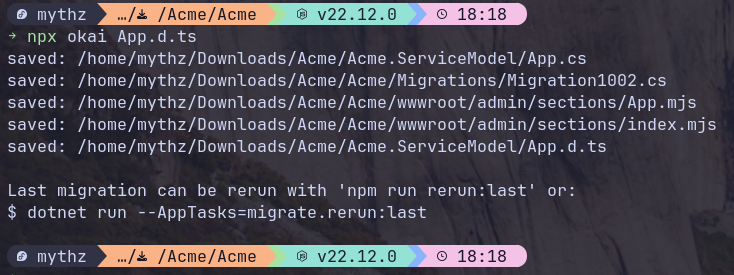Generate CRUD APIs and Admin UIs from existing DBs

A core piece of functionality in the Text to Blazor CRUD App feature is distilling an AI Prompt into TypeScript classes that can be further customized to generate AutoQuery CRUD APIs and Admin UIs for managing the underlying RDBMS tables.
TypeScript Data Models
Using TypeScript to define models is a flexible and effortless way to define your data models as it offers a DSL-like format with minimal boilerplate that's human-friendly to read and write that can also leverage TypeScript's powerful TypeScript Type System to provide a rich authoring experience with strong typing and intellisense that's validated against the referenced api.d.ts schema containing all the C# Types, interfaces, and attributes used in defining APIs, DTOs and Data Models.
Blueprint for Code Generation
The TypeScript Data Models then serve as the blueprint for generating everything needed to support the feature in your App, including the AutoQuery CRUD APIs, Admin UIs and DB Migrations should you prefer to re-create it from scratch.
RDBMS Metadata AppTask
The first step in generating TypeScript Data Models is to capture the metadata from the existing RDBMS tables which
we can do with the App.json AppTask below which uses your App's configured
RDBMS connection to generate the Table Definitions for all tables in the specified RDBMS connection and schema
to the file of your choice (e.g App_Data/App.json):
AppTasks.Register("App.json", args =>
appHost.VirtualFiles.WriteFile("App_Data/App.json",ClientConfig.ToSystemJson(
migrator.DbFactory.GetTables(namedConnection:null, schema:null))));
This task can then be run from the command line with:
dotnet run --AppTasks=App.json
Which will generate the App_Data/App.json file containing the table definition metadata for all tables in
the specified RDBMS.
Different Connection or DB Schema
If you prefer to generate the metadata for a different connection or schema, you can create a new AppTask
with your preferred namedConnection and/or schema, e.g:
AppTasks.Register("Sales.json", args =>
appHost.VirtualFiles.WriteFile("Sales.json", ClientConfig.ToSystemJson(
migrator.DbFactory.GetTables(namedConnection:"reports",schema:"sales"))));
Generate TypeScript Data Models
The next step is to generate TypeScript Data Models from the captured metadata which can be done with the okai tool
by running the convert command with the path to the App.json JSON table definitions which will generate the
TypeScript Data Models to stdout which can be redirected to a file in your ServiceModel project, e.g:
npx okai convert App_Data/App.json > ../MyApp.ServiceModel/App.d.ts
Generate CRUD APIs and Admin UIs
The data models defined in the App.d.ts TypeScript Declaration file is what drives the
generation of the Data Models, APIs, DB Migrations and Admin UIs.
Customize Data Models
This can be further customized by editing the TypeScript Declaration file and re-running the okai tool
with just the filename, e.g:
npx okai App.d.ts
Which will re-generate the Data Models, APIs, DB Migrations and Admin UIs based on the updated Data Models.

TIP
You only need to specify the App.d.ts TypeScript filename (i.e. not the filepath) from
anywhere within your .NET solution
Live Code Generation
If you'd prefer to see the generated code in real-time you can add the --watch flag to watch the
TypeScript Declaration file for changes and automatically re-generate the generated files on Save:
npx okai App.d.ts --watch




